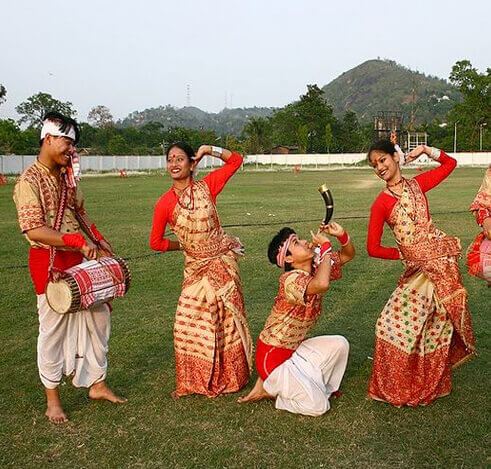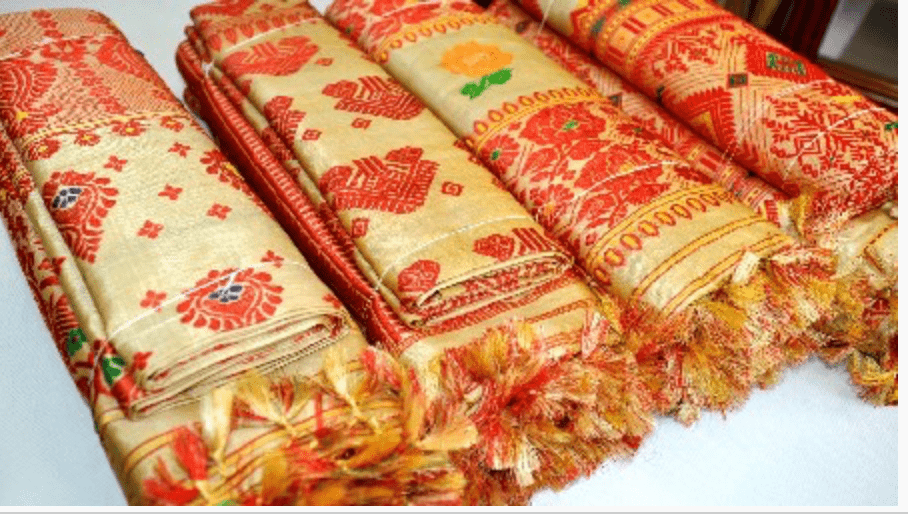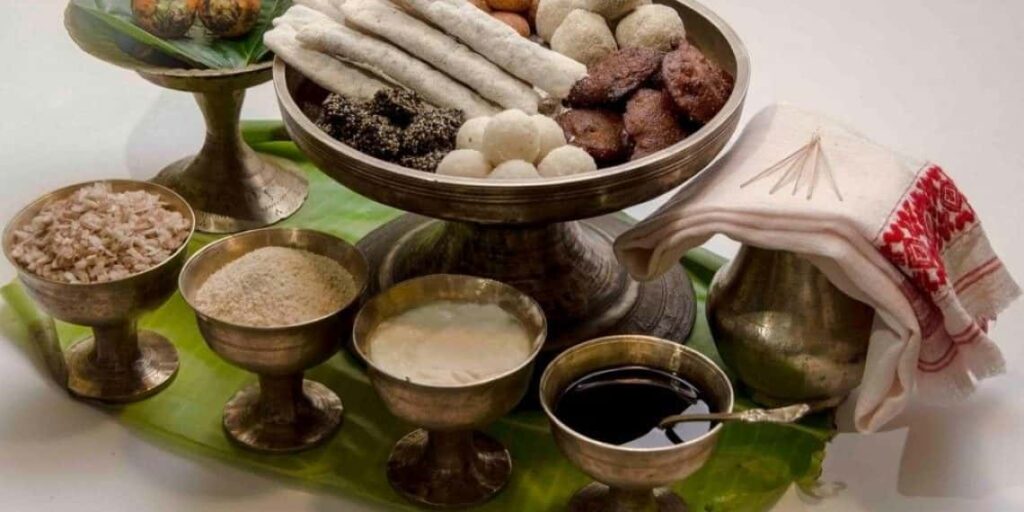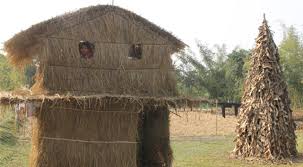What is the Bihu festival and why is Bihu celebrated?
Bihu festival is one of the most important cultural ceremony in Assam ( a North Eastern state of India ). It celebrates the change of season.
The Bihu festival is mainly observed by assamese people. It marks the beginning of the Assamese New Year and the harvesting season. The word Bihu originated from the Deori (a assamese tribal language) word Bishu which means “extreme joy”.
How many times bihu is celebrated in a year?
Assamese people celebrate Bihu thrice in a year. In January ( Bhogali Bihu ) to celebrate the harvesting season, in April ( Rongali Bihu ) to acknowledge the sowing season and in October ( Kati Bihu ) to pray for the growing crops.
What are the three types of Bihu?
The three types of Bihu are:
- Rongali Bihu or Bohag Bihu, observed in April
- Kongali Bihu or Kati Bihu, observed in October
- Bhogali Bihu or Magh Bihu, observed in January
Rongali Bihu or Bohag Bihu festival:
People celebrate Rongali Bihu ( also known as Bohag bihu ) in the month of Vaisakha ( first month of Hindu calendar ). This festival marks the beginning of Assamese New year and welcomes the spring. This festival coincides with many other festivals in India which are celebrated around the same time of the year.
Rongali Bihu marks the sowing season. The farmers are ready to sow seeds for the coming harvest. It is a set of seven festivals and also known as Xaat ( seven ) Bihu.
What are the seven phases of Bohag Bihu or Rongali Bihu?
The seven types of Rongali Bihu are :
- Goru Bihu
- Manuh Bihu
- Raati Bihu
- Chot Bihu
- Kutum Bihu
- Chera Bihu
- Mela Bihu
Goru Bihu
Goru ( cow ) Bihu is celebrated as a day for cattles. On this day people take their cattles to nearby water bodies and cleans them using turmeric-gram paste.
The cattles are bathed, worshipped and are fed with vegetables. While feeding the cattles the farmers prays and sings as a gesture of thanks for cooperating and providing them with good harvest.
Manuh Bihu
These Bihu marks the first day of the Assamese New Year. On these day people wakes up early in the morning and clean themselves.
They pray to God for the wellbeing and good harvest for upcoming Year and seeks blessings from elders. People greets each other with Bihubaan ( gifts ). They have special delicacies like laru ( made of coconut and sugar ), pitha ( made of rice flour with fillings of jaggery, coconut ).
The two Bihus mentioned above are followed by Raati Bihu, Chot Bihu, Kutum Bihu, Chera and Mela Bihu. One of the main attraction of Bohag Bihu is the Bihu Dance. As the flower kopou phool(Rhyncostylis retusa) blooms it marks the arriving spring.

Men and women dances with the music of dhol(two faced drum), pepa(buffalo horn pipe), flute, taal, gogona(made of bamboo). Mostly Male members play these traditional musical instruments and the females play gogona. They sing Bihugaan ( Bihu songs ).


What is the traditional dress of Bihu Dance?
The women are draped in beautiful traditional wear called Mekhela chador. The unique draped style of the mekhela-chador makes it more attractive. The females uses kopou phool as ornament of hair buns. The Assamese men wear traditional dhoti-gamosa. Gamosa is a traditional towel which is also used as a wrap around the head by male Bihu dancers.


As a whole people of Assam celebrates these festival with great pomp and show.
Kati Bihu or Kongali Bihu:
People of Assam celebrates Kati Bihu in the month of october ( mid of the month ). Kati Bihu is also known as Kongali Bihu. The word “kongali” refers to the state where there is a lack of abundance.

Importance of Kati Bihu:
- During this festival people lights earthen lamp in the agricultural fields, on the doorstep of their houses and near the “tulsi manch (an altar for Basil plant”. As the basil plant is believed to be sacred so it is worshipped in most of the parts of India.
- In the occasion of Kati bihu the crops are growing in the fields and the granaries are almost empty. It is believed that in ancient times the light of the earthen lamp attracts insects thus keeping the crops safe from them. People prays for the upcoming harvest to be a good one.
- People also lits sky lamp (a lantern is lit on the top of a bamboo pole). It is believed that it shows the soul of dead people the way to heaven. Therefore it is a festival of limitation and soberness.
Bhogali Bihu or Magh Bihu:
Bhogali Bihu celebrates the end of harvesting season. This Bihu is also known as Magh Bihu.
The people of Assam celebrates Magh Bihu in the month of January ( 14th and 15th ). It is the month of Magh of Assamese calendar.
Significance of Bhogali Bihu festival:
The word “bhogali” refers food. The festival is all about feast and enjoyment. During these period the granaries are full and there is food in abundance. People prepares various assamese delicacies like laru (mashed sweet coconut balls ), pitha(flattened rice cakes stuffed with jaggery), curd, chira (flattened rice flakes) etc.

People make bhelaghor or meji (a hut made with dry leaves, bamboo etc). They make these huts and burn those on the day of Bhogali Bihu. Various delicacies made with chicken , pork , goat, duck etc are being prepared at the night of Uruka.

What is Uruka?
Uruka is the first day of Bhogali Bihu. People have feasts, they dances, sings and enjoys the entire night. They eat their food inside the bhelaghor.
On the second day of these festival people wakes up early in the morning and gets freshen up. After taking the morning bath they gather around the bhalaghor. People burn the hut as a part of ritual. The people around the bhelaghor prays for prosperity and wishes for the spirits to fly away with the fire. After that they have their traditional delicacies like laru, pitha, chira ,curd.
To sum up, the festival of Bihu signifies the importance of agriculture. Subsequently it also tells about the unity and integrity of the state. Firstly, it tells us that how every changing season brings a string of celebration. Secondly, in every type of Bihu it shows the love and respect for nature. Thirdly, and most importantly the festival of Bihu tells us about the rich and beautiful culture of Assam.

November 1, 2020 at 7:35 pm
Good information on Bihu
November 3, 2020 at 7:38 am
Thankyou.
November 3, 2020 at 10:42 am
Nice info
November 5, 2020 at 7:08 pm
Thankyou
November 4, 2020 at 12:00 pm
Very good information on bihu festival